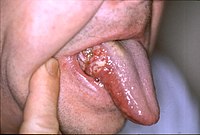
Photo from wikipedia
Objectives The tongue is identified as a high-risk site for oral leukoplakia and malignant transformation. The purpose of this study is to investigate the clinicopathological characteristics and treatment outcomes of… Click to show full abstract
Objectives The tongue is identified as a high-risk site for oral leukoplakia and malignant transformation. The purpose of this study is to investigate the clinicopathological characteristics and treatment outcomes of tongue leukoplakia and assess the factors related to recurrence and malignant transformation. Materials and methods One hundred and forty-four patients who received carbon dioxide laser surgery for tongue leukoplakia from 2002 to 2019 were analyzed statistically. Results The follow-up period was 54.90 ± 54.41 months. Thirty patients showed postoperative recurrence (20.83%), and 12 patients developed malignant transformation (8.33%). The annual transformation rate was 2.28%. Univariate analysis showed that a history of head and neck cancer, size of lesion area, clinical appearance, and pathology were significant factors for both recurrence and malignant transformation. In the multivariate logistic regression, a history of head and neck cancer and size of lesion area were independent prognostic factors for recurrence, and a history of head and neck cancer was the only independent factor for postoperative malignant change. Conclusions Clinicians should adopt more aggressive strategies for tongue leukoplakia patients with a history of head and neck cancer. Clinical relevance These results may help clinicians gain a better understanding of oral tongue leukoplakia.
Journal Title: Clinical Oral Investigations
Year Published: 2021
Link to full text (if available)
Share on Social Media: Sign Up to like & get
recommendations!